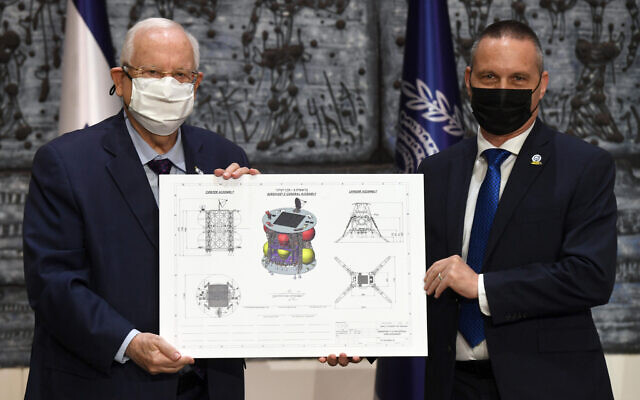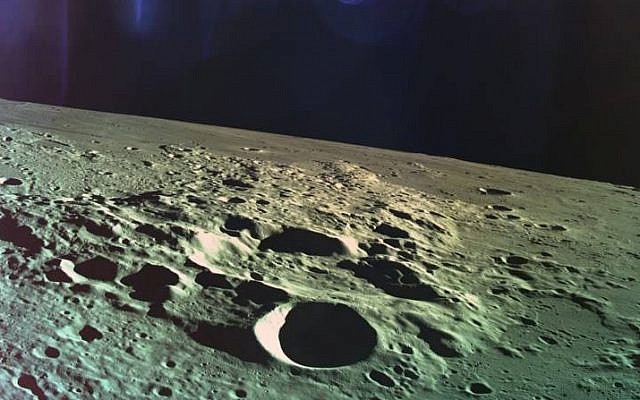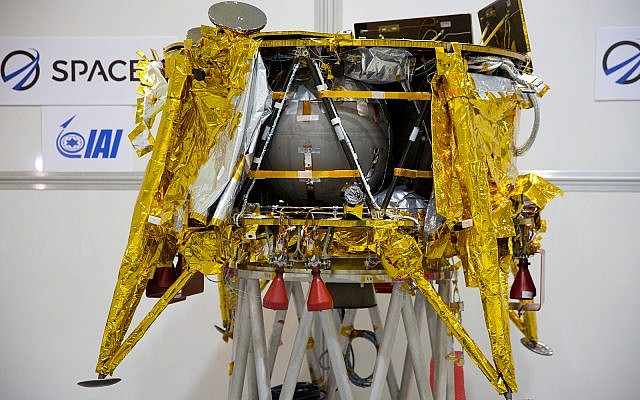Israel announced plans on Wednesday to send a second spacecraft — Beresheet 2 — to the moon, following the crash landing of the original Beresheet probe last year.
Unveiling the project with President Reuven Rivlin at his residence in Jerusalem, the Israeli nonprofit SpaceIL, in cooperation with Israel Aerospace Industries and the Israeli Space Agency at the Ministry of Science and Technology, said that it aims to launch the probe in 2024.
Having said soon after last year’s attempt that a repeat moon landing effort was “not challenging enough,” SpaceIL said Tuesday that the new probe will be a significant advancement on the first and will actually comprise three spacecraft – one orbiter and two landers. Specific plans for the scientific research set to be carried out were not revealed.
Beresheet 1, the world’s first privately funded moon lander, collided with the lunar surface in April 2019 during an attempted landing, due to technical failure.
“Just a year and a half ago, we were here together, when Israel held its breath and looked to the stars. We anxiously watched the Beresheet spacecraft on its historic journey to the moon. We watched its long journey, were in wonder at the researchers and were filled with pride at the Israeli daring and ability that flourished right here and at the groundbreaking work of Space IL.
“We were disappointed, and realized that we had to start once again from the beginning,” Rivlin said at the announcement.

President Reuven Rivlin (L) and Science and Technology Minister Izhar Shay unveiling plans for Beresheet 2, December 9, 2020. (Haim Zach/GPO)
“Today, we are setting out on a new path, familiar but different, at the end of which we hope to land three spacecraft safely on the moon,” said the president, adding that “the project will extend the boundaries of human knowledge with groundbreaking scientific experiments, helping us to understand better the universe in which we live.”
Beresheet means beginning, and is also the Hebrew name for the Book of Genesis.
Less than 48 hours after the crash, SpaceIL chairman Morris Kahn announced the launch of the Beresheet 2 project. The South Africa-born billionaire donated much of the funding for the first effort.
SpaceIL CEO Shimon Sarid said that with the new $100 million project, funded mostly by donations, the Jewish state was “aiming high… not just to outer space, but to the long-term future of the State of Israel.

A conceptual schematic for the Beresheet 2 lander, released to the media on December 9, 2020. (Haim Zach/GPO)
“We will do it by raising curiosity and hope, the ability to dream and realize and through strengthening technological education, research, science and engineering for Israeli students. By doing so, we will ensure Israel’s technological mobility for today’s schoolchildren who are tomorrow’s scientists and engineers,” he said.
The first Beresheet effort also cost nearly $100 million and was funded almost entirely by private donations from well-known Jewish philanthropists, including Miriam and Sheldon Adelson, Lynn Schusterman, and others.
The new project is expected to be similarly funded.

One of the last photos taken by Beresheet before it crash-landed into the moon, on April 11, 2019. (Courtesy SpaceIL)
Beresheet 1 was developed in response to the Google Lunar X Prize competition, which challenged nongovernmental groups to land a spacecraft on the moon. The prize committee decided days after the crash that it would award SpaceIL a $1 million “Moonshot Award” for its achievements.
Science and Technology Minister Izhar Shay said that seven countries from five continents have expressed an interest in participating in the project, and that in conversations with the United Arab Emirates, the subject has been raised several times.”
“I have no doubt that Beresheet will once again spark our imagination, redefining the boundaries of the possible and securing Israel’s status as a powerhouse of innovation,” he added.
Article From & Read More ( Israel launches second bid to put a lander on the moon; UAE may join - The Times of Israel )https://ift.tt/2JQzMRx
Science

No comments:
Post a Comment